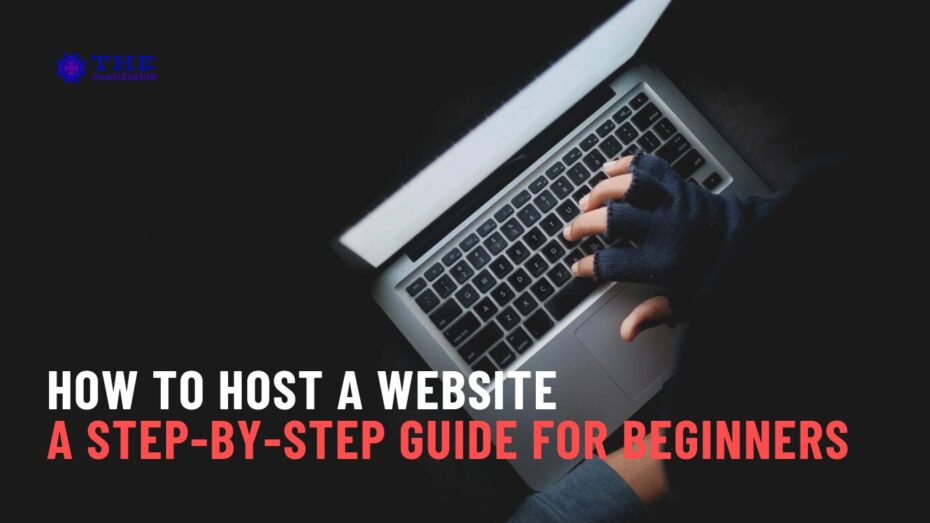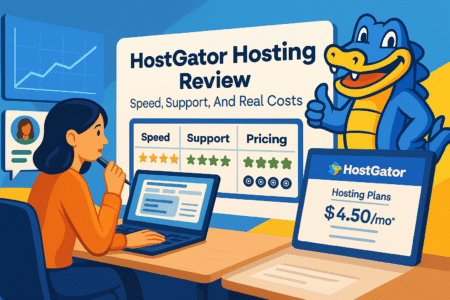Table of Contents
The digital age has introduced an abundance of opportunities, one of which is the ability to create and host your own website. Whether you’re a budding entrepreneur, a creative looking to showcase your portfolio, or simply someone with a message to share, understanding how to host a website is pivotal.
But before delving into the specifics, it’s essential to grasp the fundamental concepts of web hosting and its significance in ensuring a seamless user experience.
Understanding Web Hosting: What Is It and Why Do You Need It?
Web hosting, in its simplest form, is the process by which your website’s files and data are stored on a server, making them accessible to users worldwide via the internet. Think of it as renting a space online where your website’s content, from text and images to databases and applications, resides. Without web hosting, your website wouldn’t have a place to live, and internet users wouldn’t be able to access or find it.
But why is it essential? Firstly, the digital landscape thrives on accessibility. When someone types your website’s address into their browser or clicks on a link leading to your site, they are essentially trying to connect to the server hosting your website. This server then ‘serves’ them your content. In essence, hosting plays the intermediary role between your website’s content and the end user.
Moreover, not all hosting is created equal. The quality of your hosting provider can significantly influence your site’s functionality, accessibility, and overall user experience. Thus, opting for the right web hosting is not just about making your site available online; it’s about ensuring that visitors have a positive experience when they land on your site.
The Role of Hosting in Website Performance
The performance of a website isn’t merely dictated by its design or the quality of its content. The hosting platform plays an equally crucial role. Speed, uptime, and security are all intertwined with the quality of hosting service you choose.
For instance, the faster a web page loads, the better the user experience, leading to improved engagement, lower bounce rates, and potentially higher conversions. A good web host will have infrastructure in place, such as solid-state drives, optimized software, and robust server hardware, to ensure rapid page load times. Furthermore, with mobile browsing surpassing desktop, it’s more important than ever to ensure that web hosting is optimized for mobile devices.
Uptime is another critical factor. It refers to the amount of time your website is available and operational. Even the slightest downtime can translate to lost visitors and potential business, especially for e-commerce websites where every second count. An efficient hosting service will guarantee high uptime percentages, ensuring your site remains accessible most of the time.
Lastly, in a world increasingly conscious of privacy and security, your website needs to be fortified against potential threats. Web hosting providers are responsible for ensuring that data is regularly backed up, offering SSL certificates for encrypted data transfer, and providing protection against malicious attacks.
How to Host a Website: Essential Pre-requisites
Before you embark on the journey of hosting your website, it’s crucial to lay a solid foundation. Just like constructing a building requires meticulous planning, from choosing the right plot to deciding the structure, your digital venture demands the same diligence.
Navigating the vast digital landscape begins with three fundamental steps: selecting a domain name, defining your website’s purpose, and anticipating traffic to ensure adequate bandwidth and storage.
Picking the Right Domain Name
Your domain name is the virtual address at which visitors will find you. It’s the first impression, the calling card of your digital presence. When pondering how to host a website, one must prioritize the domain name’s relevance, brevity, and memorability.
Choose a domain name that mirrors your brand, service, or content, ensuring instant recognition. For instance, a bakery might lean towards domain names like ‘FreshBakeDelights.com’ or ‘MorningMuffins.com’. Steer clear of overly complicated spellings or lengthy names, as these can be hard for users to remember or type correctly.
Also, consider the domain extension (.com, .net, .org, etc.). While ‘.com’ remains a popular and widely recognized choice, there are numerous domain extensions available today that can be more specific to your industry or region.
Deciding on the Type of Website (Blog, E-commerce, Portfolio, etc.)
The next step in understanding how to host a website is recognizing its primary function. The type of website you want to launch will dictate many subsequent decisions, from hosting packages to design and functionality.
For instance, bloggers may seek platforms or hosting services tailored for content creation, emphasizing ease of use and SEO optimization. E-commerce ventures, on the other hand, would prioritize hosting solutions that support online transactions, product displays, and customer data security.
Portfolio websites, meant for photographers, designers, or artists, would require visually-rich templates and fast-loading media capabilities.
By defining the website’s core function early on, you not only streamline the hosting process but also ensure that the infrastructure supports and amplifies your website’s objectives.
Planning for Traffic: How Much Bandwidth and Storage Do You Need?
The beauty of the digital world is its limitless reach. However, this also means you need to prepare for the waves of visitors that your site might attract. Two crucial components come into play here: bandwidth and storage.
Bandwidth is akin to the width of a highway. The broader it is, the more traffic (data) it can handle simultaneously without causing congestion (slow loading times). For new websites or personal blogs, starting with moderate bandwidth might suffice. However, for larger e-commerce sites or media-heavy platforms, substantial bandwidth becomes essential to deliver a seamless user experience.
Storage, on the other hand, concerns the amount of space you have to store all your website’s files, including text, images, videos, and databases. While a basic blog might not require much storage, an e-commerce website with thousands of product images or a portfolio website with high-resolution media will need ample storage space.
When exploring how to host a website, it’s crucial to anticipate these needs. Overestimating can lead to unnecessary costs, while underestimating can result in poor website performance or additional charges.
Different Types of Web Hosting Services
Choosing where and how to host a website can seem like navigating a maze, especially with the plethora of hosting options available today. Each hosting type caters to different needs and offers distinct advantages and drawbacks.
By understanding these differences, you can make an informed decision tailored to your website’s specific requirements. Let’s take a closer look at two of the most commonly used hosting services: shared hosting and VPS hosting.
1. Shared Hosting: Pros and Cons
When starting on the path of understanding how to host a website, many initially turn to shared hosting, and for good reason. As the name suggests, shared hosting involves multiple websites sharing a single server and its resources, such as memory, storage, and bandwidth.
Pros:
- Cost-Effective: One of the most significant advantages of shared hosting is its affordability. With resources being split among several users, costs are low, making it an attractive option for those just beginning their online journey or operating on a tight budget.
- Ease of Use: Shared hosting often comes with user-friendly control panels and one-click installations for popular platforms and applications, reducing the technical know-how needed to get a website up and running.
Cons:
- Limited Resources: The shared nature of this hosting type means that if one website on the server experiences a surge in traffic, it can slow down others, potentially impacting performance.
- Security Concerns: Sharing a server with multiple websites can pose security risks, especially if one of those sites becomes compromised. Shared environments can be more vulnerable to cyber threats compared to more isolated hosting solutions.
2. Virtual Private Server (VPS) Hosting
A step above shared hosting, VPS hosting offers a middle ground between shared environments and having your dedicated server. In VPS hosting, a single physical server is divided into multiple virtual servers using software. While these virtual servers share the same physical resources, they operate independently, mimicking the behavior of separate physical servers.
Advantages:
- Dedicated Resources: Despite sharing the same physical server, each VPS has allocated resources, ensuring consistent performance regardless of the traffic spikes in other virtual servers.
- Enhanced Security: With each website hosted on its virtual server, there’s a clear demarcation of resources. This separation adds an extra layer of security, reducing the risk posed by compromised websites on the same physical server.
- Greater Flexibility: VPS hosting often grants more control over the server environment, allowing users to customize server settings and install specific software to meet their needs.
Drawbacks:
- Higher Cost: While VPS hosting offers more resources and control than shared hosting, it comes at a higher price point, making it a slightly more significant investment.
- Requires Technical Knowledge: To fully harness the potential of a VPS, one might need a better understanding of server management or even consider hiring a system administrator.
3. Dedicated Server Hosting
In the vast realm of how to host a website, dedicated server hosting stands out as the choice for those seeking top-tier performance, security, and control. Unlike shared or VPS hosting, where resources are split among users, a dedicated server is exclusively reserved for a single user or website.
The primary allure of dedicated server hosting lies in its unmatched resources. Here, the entirety of the server’s memory, storage, and processing power caters solely to one website, ensuring consistent and peak performance. This exclusivity translates to faster load times, a boon for websites with high traffic volumes or resource-intensive applications.
However, this luxury comes with increased responsibility. Users have the freedom to customize the server environment, from choosing the operating system to tweaking server settings. This level of control is ideal for businesses with specific requirements that standard hosting packages can’t fulfill.
Yet, such power demands a heightened level of technical expertise. Managing a dedicated server might necessitate a deeper understanding of server administration. Additionally, the costs associated with dedicated server hosting are considerably higher than shared or VPS solutions, making it an investment suited for established businesses or large-scale websites.
4. Cloud Hosting
Cloud hosting is the embodiment of the modern approach to how to host a website. Instead of relying on a single server, cloud hosting harnesses the power of multiple interconnected servers, forming a ‘cloud’ of resources. This unique structure bestows websites with unparalleled scalability and reliability.
The interconnected nature of cloud hosting means resources are virtually limitless. If a website experiences an unexpected surge in traffic, additional resources from the cloud can be allocated instantaneously, ensuring smooth performance. This scalability is particularly beneficial for businesses that experience fluctuating traffic patterns.
Moreover, the distributed nature of cloud hosting enhances website uptime. If one server in the cloud faces issues, another seamlessly takes over, virtually eliminating downtime.
On the flip side, cloud hosting’s pricing model can be unpredictable. Costs are often based on usage, meaning if your site consumes more resources one month, you’ll see a higher bill. Additionally, while cloud hosting offers flexibility and scalability, it might not provide the same level of customization as a dedicated server.
5. Managed WordPress Hosting (if focusing on WordPress)
For those specifically venturing into how to host a website on WordPress, managed WordPress hosting emerges as a tailor-made solution. This hosting type is optimized for WordPress, the world’s most popular content management system.
Managed WordPress hosting takes the guesswork out of server management. Providers handle technical aspects like updates, backups, and security, allowing users to focus solely on content creation and design. These platforms are also fine-tuned for WordPress performance, ensuring rapid page loads and smooth operations.
Additionally, such hosting often comes with expert support familiar with WordPress intricacies, ensuring efficient problem resolution.
However, this convenience and optimization come at a cost. Managed WordPress hosting is typically more expensive than standard shared hosting. Additionally, these platforms are exclusively for WordPress, meaning users are restricted from using other content management systems or applications.
How to Host a Website: A Step-by-Step Guide
Embarking on the journey of establishing a digital presence often begins with understanding how to host a website. Like constructing a house, each step, from laying the foundation to installing utilities, is crucial. Here, we unravel the process in a comprehensive, step-by-step guide to ensure your website stands robustly in the vast expanse of the digital realm.
Choose a Reliable Web Hosting Provider
When pondering how to host a website, your first pit stop is selecting a web hosting provider. This decision can liken to choosing a plot of land for your house. Just as the quality and location of land can influence your house’s value and stability, the reliability of a hosting provider impacts your website’s performance and security.
Given the multitude of hosting providers vying for your attention, prioritize those known for excellent uptime, robust security measures, and commendable customer support. Reviews, testimonials, and industry recommendations can serve as a compass, guiding you to providers that have consistently delivered on their promises.
Additionally, consider your website’s specific requirements. For instance, a small personal blog may thrive on shared hosting, while an expansive e-commerce platform might necessitate the power and control of a dedicated server. Ensure your chosen provider offers hosting solutions tailored to your website’s demands.
Register Your Domain Name (if not included with hosting)
Now, as you delve deeper into how to host a website, consider your domain name as your website’s address in the digital neighborhood. It’s how visitors will locate you amidst the bustling online crowd.
Selecting a domain name involves a blend of creativity and strategy. Ensure it’s reflective of your brand, easy to recall, and devoid of complex spellings or numerals. Once you’ve brainstormed a list of potential names, you’ll need to check their availability.
Many hosting providers offer domain name registration as part of their package, streamlining the process. However, if yours doesn’t, there are numerous domain registrars where you can secure your chosen name.
Remember, just like real estate, some domain names, especially those that are short and memorable, can be in high demand. If your preferred name is taken, be prepared with alternatives or consider varying the domain extension (.com, .net, .blog, etc.).
Setting Up Your Hosting Account
With your domain name secured, the next chapter in how to host a website involves setting up your hosting account. Think of this step as building the foundation and walls of your house.
Upon choosing your hosting package, you’ll typically be guided through the account setup process by your provider. This involves creating an account, selecting your billing cycle (monthly, annually, etc.), and providing payment information.
Post-purchase, you’ll usually receive an email detailing how to access your hosting control panel. This control panel, often termed cPanel or its equivalent, is your website’s command center. Here, you can manage files, set up email accounts, install applications, and monitor resources.
For those who’ve chosen platforms like WordPress, many hosting providers offer one-click installations, making the process a breeze. Simply navigate to the relevant section in your control panel, click to install, and follow the subsequent prompts.
Uploading Your Website Files
Once you’ve decided how to host a website and established your hosting ground, the next natural step is populating your online space with content. Think of your website’s files as the furniture and decor that transforms an empty house into a cozy home.
If you’ve developed your website offline using tools like Dreamweaver or hand-coded it, you’ll need to upload these files to your hosting server. This is usually done through a File Transfer Protocol (FTP) client. The FTP is like a bridge between your computer and your hosting server, allowing for the transfer of files.
To start, you’d typically need your FTP credentials, which your hosting provider usually furnishes. Using an FTP client like FileZilla or Cyberduck, you can connect to your server using these credentials. Once connected, it’s a matter of dragging and dropping your website files into the designated directory, often named ‘public_html’ or ‘www’.
For those using content management systems (CMS) like WordPress, Joomla, or Drupal, the process might be different. Instead of manually uploading files, the CMS usually offers an interface to upload content and media.
Setting up Email Addresses (e.g., yourname@yourwebsite.com)
A professional touch that often accompanies understanding how to host a website is setting up a domain-specific email address. This personalized email not only exudes professionalism but also fortifies brand identity.
To set this up, navigate to your hosting control panel. Most hosting providers offer a section dedicated to email management. Here, you can create new email accounts associated with your domain name, like contact@yourwebsite.com or yourname@yourwebsite.com.
Once created, you can configure the settings to access these emails. Many hosting providers offer webmail access, allowing you to check and send emails directly through a browser. Alternatively, you can set up your domain-specific email on email clients like Outlook or Thunderbird or even synchronize it with platforms like Gmail.
Testing Your Website to Ensure It’s Live
Now that the foundational elements on how to host a website are in place, it’s essential to verify that your digital abode is accessible to visitors. It’s akin to a housewarming; you want to ensure guests can easily locate and enter your home.
To test, simply type your domain name into a browser’s address bar. If everything’s been set up correctly, your website should display. Browse through its pages, click on links, and ensure images and media load correctly.
Moreover, to ensure a holistic user experience, consider testing across different browsers like Chrome, Firefox, and Safari. Each browser might render websites slightly differently, so it’s crucial to ensure consistency. Also, in this mobile age, check how your website appears and functions on smartphones and tablets.
Lastly, remember that propagation might cause delays. When you first set up or make changes to how you host a website, these modifications can take anywhere from a few hours to 48 hours to reflect globally due to the DNS propagation process.
Essential Features to Look for in a Hosting Provider
Venturing into the digital realm and deciphering how to host a website is an expedition of its own, replete with decisions that shape the online experience you offer to visitors. Central to this journey is selecting a hosting provider, akin to choosing a foundation for a building.
While many factors play into this choice, there are some non-negotiable features that stand out, ensuring the stability and reliability of your website.
Uptime Guarantee
In the digital world, where your website serves as the front door to your business or personal space, its accessibility becomes paramount. The concept of uptime delves into this very accessibility, signifying the amount of time your website is available and operational. Thus, when understanding how to host a website, the uptime guarantee of a hosting provider emerges as a crucial factor.
An uptime guarantee, often expressed as a percentage, provides an insight into the reliability of a hosting service. For instance, a 99.9% uptime guarantee suggests that your website will be operational 99.9% of the time, equating to about 8.76 hours of downtime in a year.
At first glance, these numbers might seem impressive. However, in a digitally driven era, even a few hours of inaccessibility can translate to lost opportunities or frustrated users.
Consequently, seek providers that not only offer high uptime guarantees but also have a proven track record of meeting these promises. It’s a testament to their infrastructure robustness, redundancy measures, and overall commitment to ensuring your digital space remains open to visitors round the clock.
Customer Support Quality
As you continue to unravel how to host a website, you’ll realize that the digital landscape, while exciting, is dotted with uncertainties. From server outages to technical glitches, challenges can arise unexpectedly. In such scenarios, the quality of customer support offered by your hosting provider becomes your safety net.
A competent customer support team is more than just a troubleshooting squad; they’re partners who assist you in navigating the intricacies of hosting. Whether you’re facing issues with email setup, website migrations, or security concerns, a responsive and knowledgeable support team can make the difference between prolonged website issues and quick resolutions.
When gauging the quality of customer support, consider multiple factors:
- Availability: Do they offer 24/7 support? Is assistance available through various channels like live chat, phone, or email?
- Response Time: In the world of hosting, time often equates to money or reputation. How quickly does the support team address concerns?
- Expertise: Are the support representatives well-versed in addressing a range of hosting issues? Do they provide actionable solutions or merely generic responses?
- Resource Availability: Beyond direct support, does the provider offer extensive knowledge bases, tutorials, or forums? Such resources can empower you to resolve minor issues independently.
Backup Solutions and Security Measures
In the realm of understanding how to host a website, one quickly realizes that the digital world, much like our physical one, is fraught with unpredictability. From sudden server failures to unexpected cyber-attacks, multiple scenarios can jeopardize your website’s data. Herein lies the essence of backup solutions and security measures.
When entrusting a hosting provider with your website, consider it akin to entrusting someone with the blueprints of your dream home. Just as you’d want those blueprints safeguarded from potential calamities, your website’s data demands similar protection.
Backup solutions provided by hosting services act as this safeguard. They ensure that periodic copies of your website data are stored securely. Should anything untoward occur, these backups serve as a lifeline, enabling swift restoration.
But, it’s not just about having backups; it’s about the frequency, ease of restoration, and storage location. A stellar hosting provider will offer daily backups, straightforward restoration methods, and even off-site backup storage, further minimizing data loss risks.
Complementing backups, security measures form the second line of defense in the how-to host a website playbook. These measures include firewalls, malware scanning, and SSL certificates, creating a fortified barrier against cyber threats.
When vetting hosting providers, it’s vital to discern their proactive stance on security. Are they merely reactive, addressing issues as they arise, or do they continually update and enhance their security protocols to thwart emerging threats?
Scalability and Upgrade Options
Another chapter in the quest to understand how to host a website is acknowledging that digital aspirations, much like personal ones, evolve. Today’s blog might morph into tomorrow’s e-commerce giant, or a portfolio website might expand to accommodate a burgeoning clientele. This growth trajectory necessitates scalability.
In the hosting context, scalability refers to the ease with which you can adjust your hosting resources to match your website’s demands. If your website witnesses a sudden surge in traffic, can your hosting plan adapt without causing site slowdowns or crashes?
Similarly, upgrade options are pivotal. As your website grows, so will its resource demands. Starting on shared hosting might be cost-effective, but as your digital footprint expands, dedicated servers or cloud hosting might beckon. The transition between these plans should be seamless, devoid of unnecessary migrations or extended downtimes.
When deciphering how to host a website with a future-forward perspective, prioritize hosting providers that offer a spectrum of plans. Moreover, their support team should actively guide you through transitions, ensuring that upgrades are smooth and devoid of hiccups.
Tips and Best Practices When Hosting a Website
Embarking on the digital journey of hosting a website can often feel akin to navigating an expansive ocean. The horizon might seem endless, and the waters, while calm at times, can turn tumultuous without warning.
However, seasoned sailors equip themselves with knowledge, harnessing the best practices to chart a smooth course. In the same vein, when you grasp how to host a website, adopting certain guidelines can transform your voyage from daunting to delightful.
Keeping Your Website Updated and Secure
In the realm of how to host a website, the narrative often revolves around choosing a provider, selecting a plan, and then embarking on the creation process. However, a website, much like a flourishing garden, demands continuous attention.
To begin with, always ensure your website’s software, whether it’s a content management system like WordPress or an e-commerce platform like Shopify, remains updated. Developers often release updates not just to introduce new features, but more crucially, to patch vulnerabilities. Staying updated means you’re fortifying your digital walls against potential threats.
Complementing updates, ensure you employ robust security measures. Regularly change passwords, employ two-factor authentication, and stay informed about emerging cyber threats. Remember, in the expansive digital world, it’s always better to be proactive than reactive. By diligently maintaining your website’s security health, you minimize risks and ensure a seamless experience for your visitors.
Monitoring Your Website’s Performance and Downtime
The art of understanding how to host a website transcends its creation and delves into its continuous evaluation. Just as a chef occasionally tastes their concoction to ensure perfection, monitoring your website’s performance helps in fine-tuning its user experience.
Several tools, both free and paid, offer insights into your website’s loading speeds, uptime, and overall performance. By regularly assessing these metrics, you can discern bottlenecks or areas of improvement. For instance, if a particular page consistently loads slowly, it might be burdened with large image files or unnecessary scripts.
Alongside performance, monitoring downtime is pivotal. While most hosting providers promise high uptime percentages, occasional outages, due to various reasons, are possible. Being aware of these outages ensures you can address them promptly, minimizing disruptions for your users.
Leveraging Content Delivery Networks (CDN) for Faster Load Times
In the age of diminishing attention spans, speed is not just a luxury; it’s a necessity. When delving deep into how to host a website, one can’t overlook the value of swift loading times. Here, Content Delivery Networks, or CDNs, emerge as game-changers.
A CDN comprises a network of servers spread across diverse geographical locations. Instead of a user accessing your website’s data from a singular, potentially distant server, a CDN ensures they fetch data from the nearest server in the network. This proximity drastically reduces load times, enhancing the user experience.
Furthermore, CDNs alleviate the burden on your primary server, distributing traffic loads. Especially during traffic surges, this distribution ensures your website remains accessible and functional. When contemplating how to host a website that caters to a global audience, integrating a CDN isn’t just a tip; it’s almost a mandate.
Common Mistakes to Avoid When Hosting a Website
While the digital odyssey of hosting a website is incredibly rewarding, it’s not devoid of challenges. The vast landscape of web hosting is riddled with tales of triumphs and missteps.
For every website that flourishes, there’s one that flounders, often owing to avoidable mistakes. By understanding these errors in the context of how to host a website, you equip yourself with the wisdom to sidestep them.
Choosing a Hosting Plan Solely Based on Price
In the intricate dance of how to host a website, budgeting undoubtedly plays a pivotal role. However, an overemphasis on cost savings can sometimes cloud judgment, leading one to compromise on quality. When you select a hosting plan based solely on its price tag, you might inadvertently overlook the nuances of its offerings.
While an affordable plan might seem enticing, it’s vital to discern if it aligns with your website’s demands. Does it offer sufficient bandwidth? Is the storage adequate? Are there hidden costs associated with scaling or migrating?
Remember, a website isn’t merely a digital entity; it’s an embodiment of your vision, aspirations, and brand. Cutting corners in its foundational phase might lead to larger expenses down the line, be it through lost traffic, compromised user experience, or even security breaches. As you navigate how to host a website, let value, not just price, guide your choices.
Ignoring the Importance of Backups
If there’s a cardinal sin in the realm of how to host a website, it’s the underestimation of backups. One might argue, “My hosting provider promises high uptime” or “I’ve chosen a reputed platform, what could go wrong?” However, in the digital domain, unpredictability is the only constant.
Data losses can occur due to a myriad of reasons—server failures, cyberattacks, or even human errors. In the absence of recent backups, such situations can escalate from minor hiccups to full-blown crises. Imagine the ordeal of reconstructing a website from scratch or losing valuable customer data!
As you deepen your understanding of how to host a website, recognize backups not as an optional luxury but as a mandatory insurance. It’s not just about having backups, but about their frequency, accessibility, and restoration ease.
Not Planning for Traffic Surges
Every webmaster dreams of their website witnessing a deluge of visitors. But what if this dream turns into a logistical nightmare? When you’re in the throes of understanding how to host a website, it’s crucial to anticipate and prepare for traffic surges.
These surges, often triggered by viral content, marketing campaigns, or seasonal trends, can strain your server resources. If unprepared, your website might experience slowdowns or even crash, turning a potential triumph into a debacle.
When selecting a hosting plan, assess its adaptability. Can it accommodate sudden traffic spikes? Does it offer seamless scaling options? Remember, in the world of how to host a website, it’s always better to be over-prepared than caught off guard.
Conclusion
As we draw the curtain on our voyage through the intricate seas of hosting a website, it’s crucial to not just glance back but also to peer ahead. The realm of web hosting is as dynamic as the waves, ever-evolving and constantly challenging.
Yet, with the right knowledge and approach, it becomes less about battling the tides and more about harnessing them to your advantage.
Recap on How to Host a Website Successfully
In the narrative of how to host a website, we’ve traversed a gamut of topics, each shedding light on a different facet of the process. From understanding the pivotal role of web hosting and its diverse types to discerning the nuances of various hosting plans, we’ve dived deep into the essentials.
We’ve navigated through the practical steps, starting from choosing a provider to the critical act of ensuring our website remains accessible and efficient.
Yet, beyond the technicalities and procedures, our discourse on how to host a website has echoed a singular sentiment: intentionality. Whether it’s selecting a hosting type, ensuring backups, or preparing for traffic surges, the success of a website is often rooted in thoughtful decisions and proactive measures.
Encouraging Continuous Learning and Adaptation in the Web Hosting World
Understanding how to host a website isn’t a finite journey; it’s an ongoing expedition. As the digital landscape morphs and expands, new challenges emerge, but so do novel solutions and opportunities. The tools, platforms, and technologies that seem avant-garde today might become obsolete tomorrow. In such a flux, the anchor isn’t just knowledge, but the zeal for continuous learning.
Moreover, adaptation isn’t merely a strategy; it’s a mindset. As you deepen your foray into how to host a website, cultivate a perspective that welcomes change, seeks innovation, and above all, prioritizes user experience. Remember, a website is more than code and content—it’s a dynamic entity, a reflection of a vision, and often, a bridge connecting ideas to audiences.









